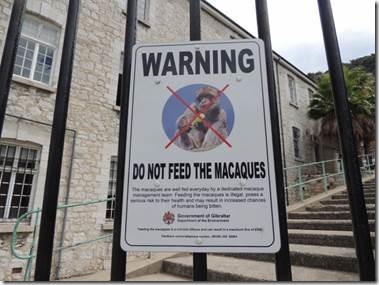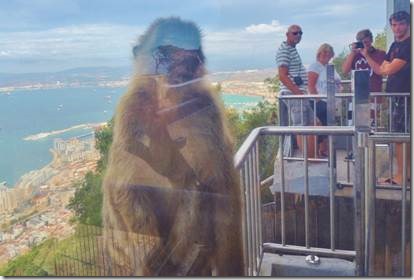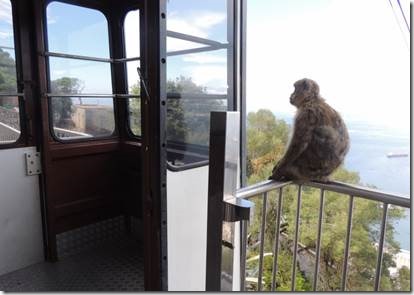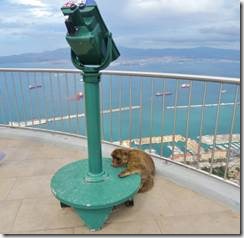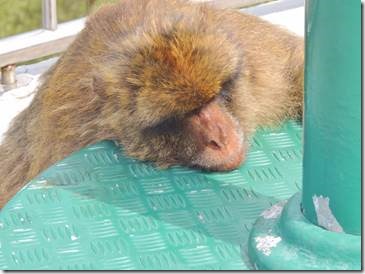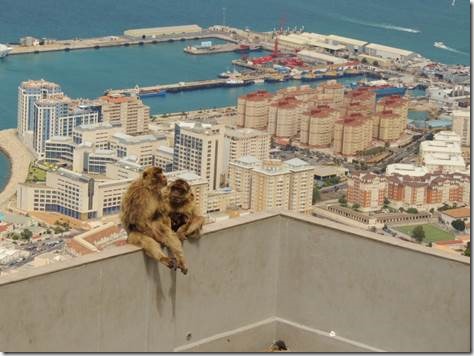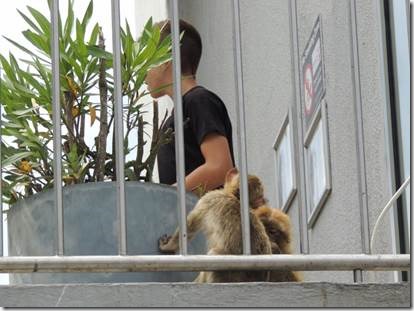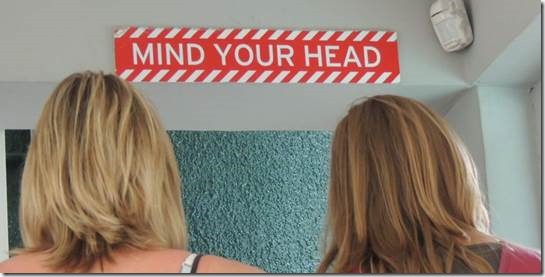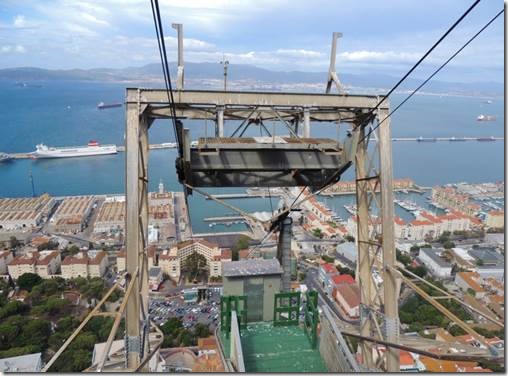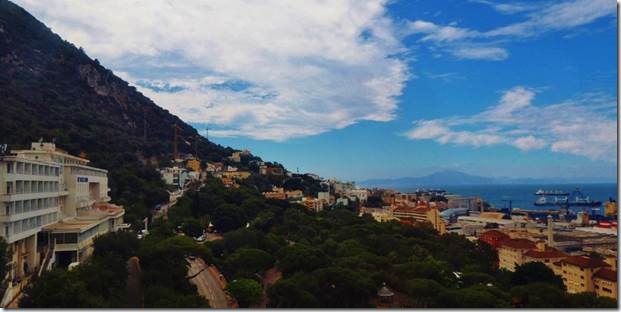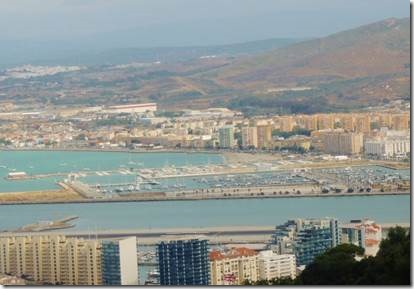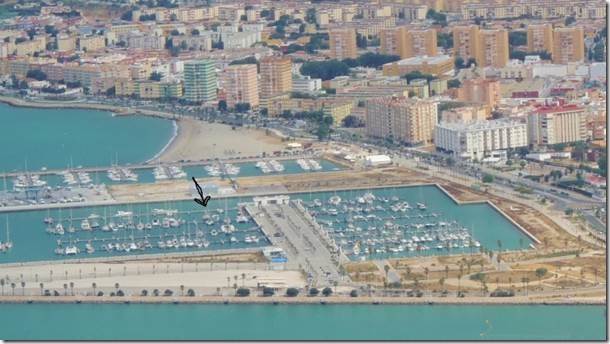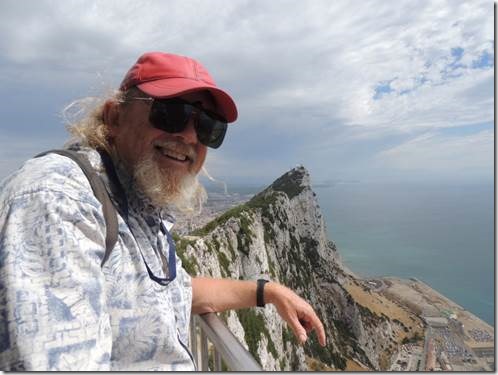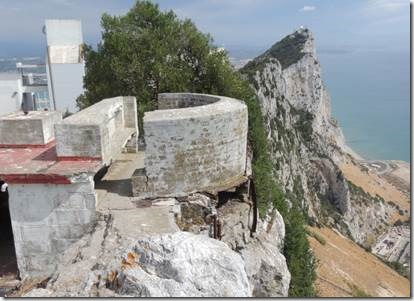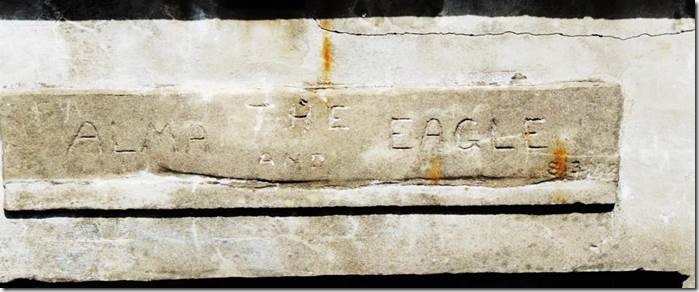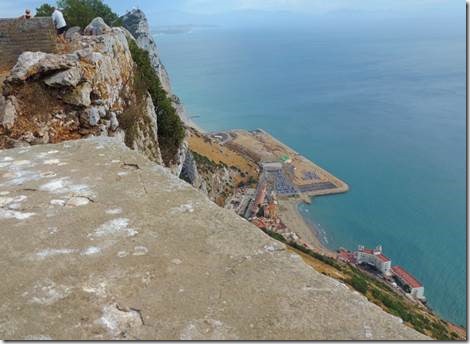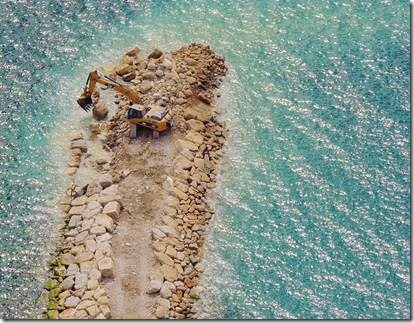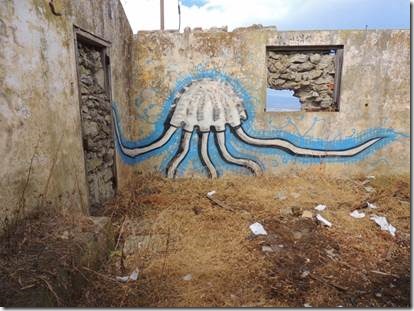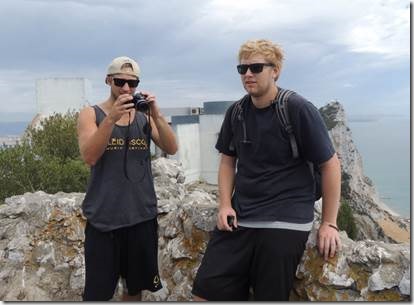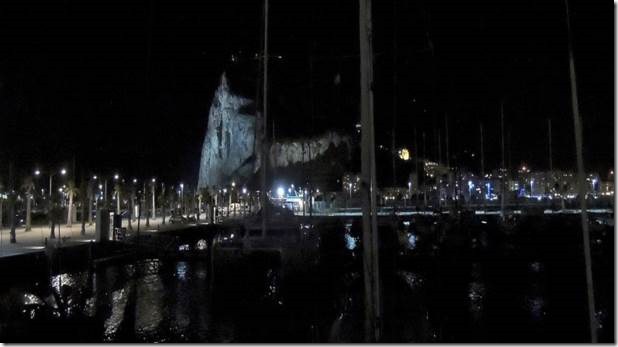Hola,
Yesterday we took the cable car to the Top of the Rock. Here’s the story.
Ru
It was a lovely clear day and most boat chores are completed, so we took the day to go to Gibraltar. We first went to The Rock taking the cable car up and down. I would have liked to walk at least one way but Randal’s heel spur is still bothering him and he really didn’t have much interest in the hike anyway. I had more interest in the hike than actually visiting The Rock plus cable cars aren’t my favorite thing. As cable cars go, this one was smooth and quick. Even with the cable car we still managed to get some walking exercise. We had walked from the marina to the border. We walked from the cable car office at the foot of the Rock back into town where we walked around looking for used book shops. We found Bell Books on Bell Lane but Terry’s in Irish Town had closed at 1 pm for the day as they do every Saturday. Then we walked back to the Market Place Terminal to get the red city bus back across the border. And then we walked from the border back to the marina. Walking does become part of your life when you live on a boat.
My favorite part of the Rock were the Barbary Apes. In Bell Books she had no copies of Scruffy and it’s not available on Kindle. Maybe Terry’s, the used book shop will have it. The clerk in Bell Books said Scruffy was out of print. It’s hard to believe that Gibraltar wouldn’t somehow find a way to have copies for sale. Someone is missing an opportunity somewhere. Just like those pomegranate possibilities on Sicily.
|
My favorite photo of the day! Barbary macaque “The Gibraltar apes are actually a tailless monkey called a Barbary Macaque (Macaca Sylvanus). No one is actually sure how they got to Gibraltar, however, speculation has it they were brought either by the Arabs sometime after 711CE or the British after 1704. The Macaque is listed as ‘endangered’ in its homelands in Algeria and Morocco but here in Gibraltar they thrive under the care of the Gibraltar Ornithological & Natural History Society (GONHS).” http://www.gibraltarinfo.gi/gibraltar-apes.aspx “Barbary macaques are the only non-human primates found in Europe. There is a small population on Gibraltar although most live in the oak and cedar forests of Morocco and northern Algeria. They are also known as Barbary apes due to their lack of a tail, but they are actually Old World monkeys. Barbary macaques live in troops of as many as 100 members and the males help care for the young, grooming and playing with them. This distinguishes them from other macaques. The males sometimes focus attention on youngsters that aren’t their offspring. This may be because females mate with all male members of the troop so paternity is uncertain. Scientific name: Macaca sylvanus Rank: Species Common names: Barbary ape, Common macaque, Rock ape” http://www.bbc.co.uk/nature/life/Barbary_macaque Scruffy by Paul Gallico (a book about the Barbary Apes of Gibraltar) Paul Gallico writes: “There is one demonstrable fact in this otherwise total work of fiction and that is on the 25th August, 1944, the Prime Minister, Winston Churchill, caused a signal to be sent to Gibraltar expressing anxiety over disquieting rumours concerning the welfare of the Barbary apes established there, and directing that every effort should be made to restore the dwindling number of apes to twenty-four, and that this number should be maintained thereafter. So much for truth. All that follows is nothing but the wildest imagination.” From this lurid imagining Paul Gallico has produced Scruffy, the ugliest, nastiest-tempered, roughest old villain of a Barbary ape. The story contains all the fertility of Gallico’s invention, sparked by his love for the British and their odd ways, his understanding of animals, maiden ladies, young lovers, choleric Brigadiers, phychologists doubling as intelligence officers, and prang-prone R.A.F. pilots. It is a unique entertainment written with the inimitable Gallico touch; and renders the unbearable Scruffy the most lovable ape of your acquaintance. ISBN: 0860090264 |
|
Don’t feed the Macaques!!! The sign on the left was posted just outside the entrance to the cable car; the other down in town. As we were waiting to get into the cable car a young woman asked her two friends if they could, either pat the monkeys or feed them, I can’t remember which. Hopefully she didn’t do either; Macaques are certainly known to bite. The Macaques on Langkawi had no interest in being friends with the humans. But, having said that, they do looks so thoughtful and “human.” “The apes come into contact with humans on a daily basis and it is through this contact they became known as ‘Bags of Fat’ being fed by well meaning but ill informed people. Their general health has improved under GONHS (Gibraltar’s Ornithological and Natural History Society) and there is now a £500 fine if anyone is caught feeding an ape. They are fed at locations around the Rock on a daily basis on a diet strictly observed by experts and though it may seem basic to you to the apes it is balanced for their health, well-being and teeth.” http://www.gibraltarinfo.gi/gibraltar-apes.aspx |
|
They are there to greet you when you arrive on the cable car. |
|
Pedestal for a pillow? It seems to need some explanation as to why the pedestal, though it is a place that attracts tourists just outside the café. And tourists sometimes offer food. |
|
I didn’t notice as I took the photo, but looking at it afterwards: not a safe place to sit! They must have no fear of heights or falling. |
|
Hide and seek |
|
Mind your head sign (getting on to the cable car ramp.) On the subway in Singapore a voice would tell you to Mind the Gap which was the space between the train and the platform. I also loved the Max Headroom signs. Britishism are fun! |
|
Half way Randal and I were in the front so we had a great view riding up. There was much you could do at the top, but we really just walked around, took photos of the “Barbary Apes”, ate some lunch and rode down again. I’m really not so much of a military history buff so just seeing the views and the apes was enough. “Perched on the very summit of the Rock of Gibraltar, with the sheer cliffs of the east face of the Rock to one side of the building and steep slopes leading to the City of Gibraltar on the west on the other is the Top Station of the Cable Car. From this spot one has uninterrupted views southwards across the Straits of Gibraltar to Africa; westwards, of the City of Gibraltar and across the Bay to Algeciras; a birds eye view of Gibraltar airport and Spain to the north; and the blue expanse of the Mediterranean and the beaches and cities of the Costa del Sol to the east. Every corner of the Rock oozes with history and it is worthwhile to take the time to find out a little about what you are looking at by either listening to a commentary on multilingual tapes available at the Top Station or by combining your trip on the Cable Car with a tour of the Rock. You might learn for example about the spot where Admiral Nelson’s body was brought ashore after his victory at the Battle of Trafalgar, or of the many tunnels inside the Rock from where General Eisenhower masterminded the invasion of North Africa in World War II, or of the fact that parts of the first Cable Car to be built in Gibraltar can still be seen (although it took the form of a basket into which a man or some ammunition might by transported to the gun emplacements which used to be located close to the site of the existing Top Station). The present Cable Car was originally constructed in April 1966 by Von Roll of Switzerland, and was extensively refurbished by the manufacturers in 1986. Within the Top Station complex there is a Self Service Restaurant, English Pub and Souvenir Shop where you can have a meal or a drink whilst enjoying the views on one of the many panoramic terraces. For the more technically minded, here are some technical data: Track length between terminal stations: 673m Vertical rise between stations: 352m Number or towers: 3 Number of cabins: 2 Capacity of cabins: 30 + 1 attendant Travelling speed: 5 m/sec http://www.gibraltar.gi/tourism/?language=en&category=1&item=15 |
|
Africa in the distance; just about the middle of the photo below the clouds. |
|
Looking down at Spain, La Linea, Alcaidesa Marina and Doramac! |
|
Randal and The Rock |
|
Remains of old cable car at Signal Station. The battery was later removed and built over by the Gibraltar Cable Car top station, however there are remains of an earlier cable station that was used to bring supplies (or a brave man) up to the top of Signal Hill. Besides the remains of earlier military buildings there is also a short tunnel that runs east to west. |
|
Signal Hill Battery, Gibraltar http://en.wikipedia.org/wiki/Signal_Hill_Battery,_Gibraltar Part of Fortifications of Gibraltar Signal Hill Battery is now Cable Car Old Ordnance Survey map showing depicting Signal Hill Battery with superimposed red area showing the footprint of the Gibraltar Cable Car top station. Type Artillery Battery Coordinates 36.134307°N 5.345732°WCoordinates: 36.134307°N 5.345732°W Built 1727 Current condition Built upon Current owner Government of Gibraltar Signal battery tunnel nissan hut remains. The remains of the Nissen hut within the battery’s tunnel. Signal Hill Battery or Signal Battery was an artillery battery in the British Overseas Territory of Gibraltar. The battery was mounted high on the rock.[1] Little remains today as the Gibraltar Cable Car top station was built on the site of the old battery. The top of the Rock of Gibraltar is a natural site for a signal station and the 1,200 feet (370 m) high Signal Hill has had a Signal Station since at least 1727. In 1773 it had its first 6-pounder gun installed.[2] The added height gave the gun an extra range and it could also fire in any direction. However, in Gibraltar height can be a disadvantage as the levanter cloud can remove the gunners’ visibility. By 1892 the gun had been updated to a BL 6 inch QF gun mounted on a Vavasseur mounting. Seven years later a second gun was added and after two more years there were four 6 inch guns and two QF 12 pounder 12 cwt gun. The latter two had depression mountings allowing them to be fired down the side of the Rock but they were removed by 1906. Remains of old cable car at Signal Station. During World War II the Rock was a target for air raids and two 3 inch 30 cwt anti-aircraft guns were mounted on the hill together with a Bofors 40 mm gun. The battery was later removed and built over by the Gibraltar Cable Car top station, however there are remains of an earlier cable station that was used to bring supplies (or a brave man) up to the top of Signal Hill. Besides the remains of earlier military buildings there is also a short tunnel that runs east to west |
|
Alma And The Eagle 83 I saw this and was curious which actually led me to the information about Signal Hill and the following… though not the explanation about Alma and the Eagle 83 “It was whilst deployed at Signal Hill that they shot down their first enemy bomber, on the night of the 20th August 1940. The entry in the unit’s War Diary reads as follows:
"Third bombing raid over Gibraltar, first plane came over at 23.30 hours and was picked up by searchlights at the moment of bomb release. It kept a steady course and AA fire was opened. Plane was hit and brought down in the straits". http://royalgibraltarregiment.gi/history_gibraltar_defence_force.php |
|
Looking down from the top at the pink roofed hotel where Randal stayed in 2000 on his world bike ride. He’d actually taken the cable car up then but wanted to go again so I could see. |
|
Building a breakwater The sounds of the workmen carried all the way to where we stood watching. |
|
Graffiti in one of the abandoned buildings |
|
Oregonians We met these two “just graduated college” fellows getting on the red bus in Spain to go to Gibraltar. We remet them just here but wish we’d gotten to them sooner as a macaque had jumped on the taller ones shoulder. They were on a month’s holiday before going back to figure out their lives. I told them to find something they cared about as it was a long time till retirement. They responded that it was exactly that to which they were giving much thought. They reminded me of the young men we’d met in Greece who were trying to also sort out their lives. Interesting thing that I can’t remember meeting any young women, except one in India on sabattacal from teaching dance at a community college. Maybe I just haven’t noticed. |
|
The Rock at night from the flybridge of DoraMac |
|
“When you first see the Rock of Gibraltar, whether it is from the air, from the sea or from the Costa del Sol, it is its impressive stature, towering isolated above the surrounding countryside, that causes the greatest impact. It has had this effect on people for many thousands of years. Gibraltar is a beacon which signals the position of the Strait of Gibraltar, the narrow neck which separates Europe from Africa and provides the only link between the Atlantic Ocean and the Mediterranean Sea. Through the following text you will be given a dated account of all the historical moments of importance involving Gibraltar.” https://www.gibraltar.gov.gi/history Go to the Gibraltar web site to read the entire history. “The Rock was formed; more or less in the shape we see it today, by a massive upheaval of the earth about 200 million years ago. While dinosaurs roamed, the earth’s plates which formed Africa and Europe collided and a massive lump of Jurassic limestone was forced up from the sea and flipped over. The top ridge of Gibraltar was once far below the sea and is made from millions of compressed seashells. Not just on the outside but on the inside too! Rainwater filtered through and cracks, fissures, caves and eventually huge caverns including St Michael’s Cave were formed. Those who use the expression ‘Solid as the Rock of Gibraltar’ stand to be reminded that it is in fact honeycombed by history – riddled with natural caves and, much later, tunnelled by man to a total of 50km of passages.” https://www.gibraltar.gov.gi/heritage https://www.gibraltar.gov.gi/about-gibraltar gives you lots of other info 1830 AD Gibraltar is declared a Crown Colony. 1848 AD A skull was found in the Forbes’s Quarry at the foot of the sheer north face of the Rock of Gibraltar. Nobody knew it at the time but it belonged not to a modern human, like us, but to a prehistoric form. It was sent to the UK where it was conserved. Eight years later in the Neander Valley near Dusseldorf in Germany another was found giving this human its name – instead of Gibraltar Man it became Neanderthal Man. 1940 AD As a consequence of the Second World War, which broke out in 1939, the civilian population is evacuated to Britain, Jamaica and Madeira, in order for Gibraltar to be fortified against the possibility of a German attack. By 1942 there are over 30,000 British soldiers, sailors and airmen on the Rock. The repatriation of the civilians started in 1944 and proceeded for some six years although the majority had returned by 1946 |



